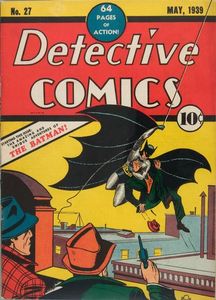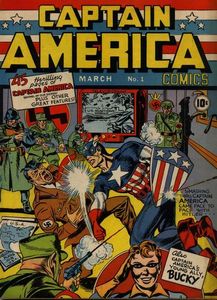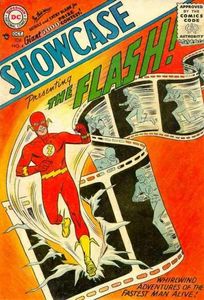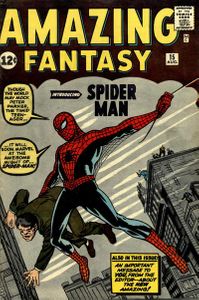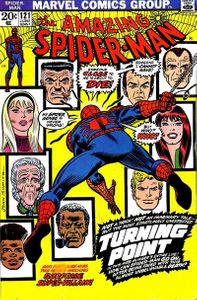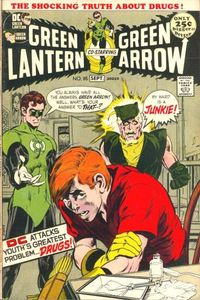I have read some great arguments on GoCollect and 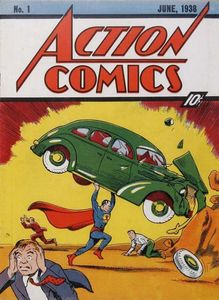
In an Age a long time ago...
There are variations and disagreements on these descriptions as a result. Instead, we go by a consensus of the time frame and the defining trends that make up what we call the different Ages of comic books. So let's look at those Ages that have since passed in an attempt for us to comprehend what has been called the "Modern Age of Comic Books".
Golden Age (1938-1955)
This was the Age when the "capes" became the trend in comics. Heroes such as Superman in Action Comics #1, Batman in Detective Comics #27, and Captain America in Captain America #1 were introduced. This was a time when America faced great hardships and needed a diversion from reality. World War II occurred during this Age and a number of classic wartime covers would inspire the reader that there was nothing that could stop the U.S.A. and its heroes from defeating their enemies.
To the latter part of this Age, science started to become a popular story theme because of innovations in technology and our goal to reach the stars. These elements soon became a popular subject of comics. Instead of fighting enemies from across the pond, readers were introduced to creatures from across the galaxy. Evil scientists were now to be feared instead of soldiers. As a result, the number of hero comics started to decrease during this period because consumer tastes had changed.
Silver Age (1956-1970 early)
This is the age where a generation of heroes was introduced and existing heroes were re-imagined. Now we had a new Flash introduced in Showcase #4 to go along with existing heroes such as Superman and Wonder Woman. DC Comics brought readers new worlds of characters that soon would be combined with heroes from the previous Age to tell their tales. Gone were the old WWII propaganda covers, replaced by covers and stories that had silliness to them that made readers forget the terrible past. Even Batman, who took on the mantle of hero because of the death of his parents, imitated his television counterpart during this time. Now we had a "dark knight" who would face enemies in stories that were more light-hearted in tone.
At Marvel Comics the Marvel Universe was created under the stewardship of Stan Lee and Jack Kirby. Teams such as the heroic family the Fantastic Four were introduced to readers. A young Peter Parker that readers could relate to was also introduced in Amazing Fantasy #15 and later given his own title to tell his exploits. Even older heroes such as Captain America were brought back out from the cold into this brave new world. This Universe was created that interconnected each of our heroes so they could meet and fight the villains of the day. A great tapestry for artists and writers now existed that let us know that good almost always triumphed over evil.
Bronze Age (1970 late-1982)
Gone was that time of innocence from the Age before. A grim, grittier period in comics began. Marvel Comics led the way with stories where an innocent friend could die in a battle between a hero and a villain in Amazing Spider-Man #121. Anti Heroes such as The Punisher and Wolverine were introduced that revealed that sometimes the heroes' hands had to get dirty to win. Societal problems also appeared in the Bronze Age. Who could forget that even though the X-Men could save the world they still were persecuted for being born mutants?
DC Comics also lost its silliness during the Bronze Age. Instead of battling a villain, a beloved sidekick would be seen fighting his own personal demons using drugs on the cover of Green Lantern/Green Arrow #85. Villains were becoming more violent, killing innocents and family members of our heroes because nothing was safe anymore. DC Comics tried to re-create the magic of the Marvel Silver Age with Jack Kirby in such books as New Gods #1 and Demon #1 but that age had passed. Our society had lost its innocence. America's involvement in a war that they would not win and social protests had lifted the veil on our problems. No area would be left untouched, not even comic books!
So what do we know and what is next?
We can see from history that the comic book Ages are not a defined period of time. Events or trends dictate when an Age has passed and a new Age has begun. We can also see some divergence among how comic companies treat these events but there exist some common elements as well. The easiest fact we can see is in the past we must label the Age with a metal. These then must be our blueprints to proceed.
When we use these variables over the time frame of 1983 to the present we can see significant events and different variables that influenced comics. Forty years without different events affecting books is not a viable option. We should be able to break the "Modern Age" down and that is what we are going to do now...
CONTINUED IN PART II ........THE COPPER AGE DEFINED
